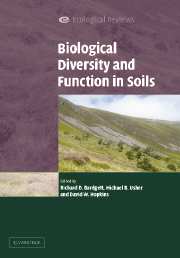Book contents
- Frontmatter
- Contents
- List of contributors
- Preface
- Acknowledgements
- PART I Introduction
- PART II The soil environment
- PART III Patterns and drivers of soil biodiversity
- PART IV Consequences of soil biodiversity
- 10 Microbial community composition and soil nitrogen cycling: is there really a connection?
- 11 Biodiversity of saprotrophic fungi in relation to their function: do fungi obey the rules?
- 12 Is diversity of mycorrhizal fungi important for ecosystem functioning?
- 13 Trophic structure and functional redundancy in soil communities
- 14 Plant–soil feedback and soil biodiversity affect the composition of plant communities
- 15 Response of the soil bacterial community to perturbation
- PART V Applications of soil biodiversity
- PART VI Conclusion
- Index
- References
13 - Trophic structure and functional redundancy in soil communities
Published online by Cambridge University Press: 17 September 2009
- Frontmatter
- Contents
- List of contributors
- Preface
- Acknowledgements
- PART I Introduction
- PART II The soil environment
- PART III Patterns and drivers of soil biodiversity
- PART IV Consequences of soil biodiversity
- 10 Microbial community composition and soil nitrogen cycling: is there really a connection?
- 11 Biodiversity of saprotrophic fungi in relation to their function: do fungi obey the rules?
- 12 Is diversity of mycorrhizal fungi important for ecosystem functioning?
- 13 Trophic structure and functional redundancy in soil communities
- 14 Plant–soil feedback and soil biodiversity affect the composition of plant communities
- 15 Response of the soil bacterial community to perturbation
- PART V Applications of soil biodiversity
- PART VI Conclusion
- Index
- References
Summary
SUMMARY
Empirical and theoretical evidence suggests that the rate and magnitude of below-ground ecosystem processes depend on the architecture of the detrital food web. Although some species have an indisputable keystone role in determining soil processes, there is little evidence suggesting that species diversity per se has any major influence at a system level.
We review studies that shed light on the degree of functional redundancy in decomposer food webs – from microbes to soil fauna. As well as emphasising the need to define accurately functional redundancy (using both ‘Hutchinsonian ecological niche’ and ‘functional niche’ concepts), we also focus on features specific to soils and their communities that may affect the levels at which functional redundancy exists in detrital food webs.
We also explore the levels of ecological hierarchy (from species to trophic levels) at which diversity differences manifest themselves as altered ecosystem-level processes.
We conclude that the high degree of generalism – even omnivory – in resource-use among decomposer organisms, and the highly heterogeneous environment of soil organisms (reducing competition between species, thus allowing taxa with similar feeding preferences/environmental tolerances to co-exist), play major roles in explaining the high degree of functional complementarity found in decomposer communities.
Introduction
The accelerating loss of biodiversity in various global ecosystems (Lawton & May 1995; Lawton 2000; Schmid et al. 2002) and recent findings emphasising the close linkage between the above- and below-ground components of ecosystems (Wardle 2002) have led many ecologists to direct their interest to soil ecology and processes.
- Type
- Chapter
- Information
- Biological Diversity and Function in Soils , pp. 236 - 249Publisher: Cambridge University PressPrint publication year: 2005
References
- 54
- Cited by

